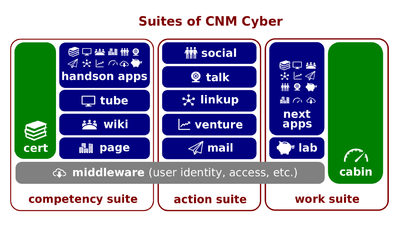Difference between revisions of "User Data in Cyber"
(→Script) |
|||
| Line 11: | Line 11: | ||
===Script=== | ===Script=== | ||
| − | : | + | :[[User data]] is any data that the end-user of a particular system (including you) creates or owns. This data has several levels. |
| − | : | + | :For instance, you have created your [[username]], but don't own that. You can possibly open a new [[user account]] and pick up a new ''username'', but this ''account'' will keep that name for its life being. |
| + | |||
| + | :You have created and own your password -- you can change it at any time through [[CNM Cabin]]. Similarly, you can manage your profile and preferences there. | ||
:The word, Cabin, in the service's name, indicates that this service provides you with a separate and private space where you can interact with [[CNM Cyber]] as a whole. | :The word, Cabin, in the service's name, indicates that this service provides you with a separate and private space where you can interact with [[CNM Cyber]] as a whole. | ||
Revision as of 20:35, 24 April 2020
User Data at Cabin (hereinafter, the Lectio) is the lesson part of the CNM Cabin Essentials lesson that introduces its participants to CNM Cabin. This lesson belongs to the CNM Cyber for Experience session of the CNM Cyber Welcome Course.
Contents
Content
The predecessor lectio is What CNM Cabin Is.
Key terms
- User data. Any data that the end-user of a particular system creates or owns.
- Username (login name, account name, handle, or, rarely, ID). The humanly-readable name of user account that the end-user utilizes to access that account. A username is an essential part of user data.
- Password (passcode). Any string of characters that is used to confirm user's identity. The NIST Digital Identity Guidelines defines a password as "the secret is memorized by a party called the claimant while the party verifying the identity of the claimant is called the verifier. When the claimant successfully demonstrates knowledge of the password to the verifier through an established authentication protocol, the verifier is able to infer the claimant's identity.
Script
- User data is any data that the end-user of a particular system (including you) creates or owns. This data has several levels.
- For instance, you have created your username, but don't own that. You can possibly open a new user account and pick up a new username, but this account will keep that name for its life being.
- You have created and own your password -- you can change it at any time through CNM Cabin. Similarly, you can manage your profile and preferences there.
- The word, Cabin, in the service's name, indicates that this service provides you with a separate and private space where you can interact with CNM Cyber as a whole.
- The overwhelming majority of records such as your exam scores or wikipage edits are collected automatically, through the algorithms that systems administrators manage.
- So, the administrators are the other party. CNM Cabin helps them manage your access to various resources such as applications, networks, and services. You have started here, at CNM Cyber, as a newbie with minimal rights. The more you learn here, the more system access permissions CNM Cabin grants.
System-User Roles is the successor lectio.
